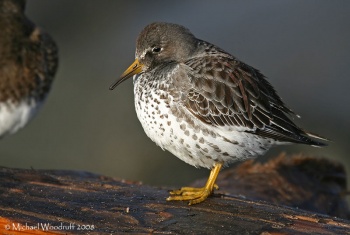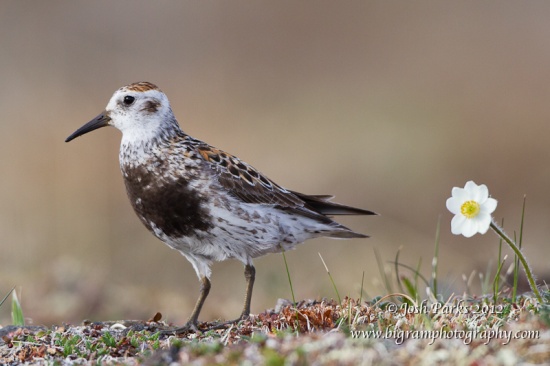- Calidris ptilocnemis
Identification
Length: 20–23 cm, weight 80–135 g
The bill is thin and dark with a yellow base, and the legs are short and drab greenish in summer, yellow in winter.
Summer: gray-brown above and on breast, with brown fringes to scapular and mantle feathers; blackish lower breast patch on some subspecies.
Winter: dark blackish-gray with a purple sheen on top, and white underneath. The breast is grey and the rump is black.
Juvenile: similar to adult summer, but lacking blackish lower breast patch in all subspecies.
Similar species
Apart from Purple Sandpiper, the only small dark wader with yellow legs likely to be seen on a rocky shore. Outside of adult summer plumage, Purple Sandpiper can only be distinguished by distribution (Atlantic coasts, versus Pacific for Rock). Surfbird is similar in plumage colors, but distinctly larger, with a shorter beak.
Distribution
Northwest North America and northeast Asia
North America: breeds in Alaska, winters in Alaska, British Columbia, Washington, Oregon and California
Asia: breeds in far eastern Russia, winters there and in northeastern Japan
Taxonomy

Photo © by Michael Woodruff
Brown Point Jetty, Ocean Shores, Grays Harbor County, Washington, 6 January 2008
Very closely related to Purple Sandpiper; in the past sometimes considered conspecific with it, particularly the subspecies C. p. couesi, C. p. quarta, and C. p. tschuktschorum[1].
Subspecies
There are 4 subspecies[2]:
- C. p. quarta:
- Kuril Islands, southern Kamchatka Peninsula and Komandorskiye Islands.
- C. p. tschuktschorum:
- Chukotsk Peninsula to western Alaska; winters north-western North America and eastern Japan.
- C. p. ptilocnemis:
- Pribilof, St. Matthew and Hall islands; winters Alaska Peninsula. Larger and paler than the other subspecies.
- C. p. couesi:
- Aleutian Islands and Alaska Peninsula.
An additional subspecies C. p. kurilensis is generally considered invalid[3].
Habitat
Rocky coasts, mudflats and tundra.
Behaviour
Breeding
Ground nesters. The male prepares a few nests and the female selects one to lay her 4 eggs. Both adults incubate the eggs, but the rearing of the chicks is left to the male.
Diet
Its diet includes insects,mollusks,marine worms, also some plant material.
References
- Hayman, P., Marchant, J., & Prater, T. (1986). Shorebirds. Helm, London. ISBN 0-7136-3509-6
- Clements, J. F., T. S. Schulenberg, M. J. Iliff, S. M. Billerman, T. A. Fredericks, B. L. Sullivan, and C. L. Wood. 2019. The eBird/Clements Checklist of Birds of the World: v2019. Downloaded from http://www.birds.cornell.edu/clementschecklist/download/
- Avibase
- BF Member observations
- Chandler, R. (2009). Shorebirds of North America, Europe, and Asia: A photographic guide. Princeton Univ. Press.
Recommended Citation
- BirdForum Opus contributors. (2025) Rock Sandpiper. In: BirdForum, the forum for wild birds and birding. Retrieved 11 May 2025 from https://www.birdforum.net/opus/Rock_Sandpiper
External Links
GSearch checked for 2020 platform.





